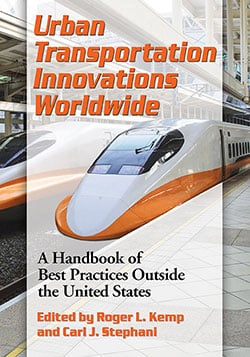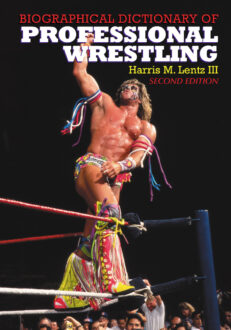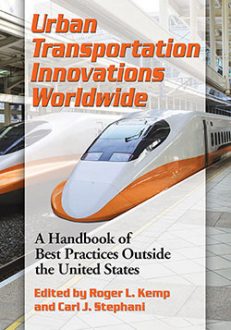Urban Transportation Innovations Worldwide
A Handbook of Best Practices Outside the United States
$39.95
In stock
About the Book
This handbook of urban transportation planning presents case studies detailing 40 best practices from 33 states in the U.S. and 19 countries on six continents. Cities around the world have improved transportation options for their citizens. Roadways have seen the addition of walkways and bicycle lanes, and light-rail transit systems have reduced street traffic. These cities have decreased reliance on personal cars and enhanced their urban environments by reducing congestion, pollution, and the number and width of roadways. This volume discusses the dynamic field of urban transportation planning and provides resources for planning professionals and public officials interested in obtaining additional information on the latest trends.
About the Author(s)
Bibliographic Details
Edited by Roger L. Kemp and Carl J. Stephani
Format: softcover (7 x 10)
Pages: 264
Bibliographic Info: appendices, glossary, notes, index
Copyright Date: 2015
pISBN: 978-0-7864-7075-4
eISBN: 978-1-4766-1827-2
Imprint: McFarland
Table of Contents
Acknowledgments vi
Preface 1
Part 1. International Transportation Planning
1. Vehicles and Sustainable Communities (Center for New Urbanism) 9
2. Transportation in the United States (Project for Public Spaces) 12
3. Land Use Planning and Cars (Troy Russ) 17
4. Smart Growth Controls Urban Sprawl (Center for New Urbanism) 20
5. Electric Cars Replace Gas-Powered Ones (Michael Horn) 24
6. Light-Rail Transit and Economic Development (Tom Brandes and Brad Scheib) 29
7. Using Buses for Rapid Transit (Sarah Jo Peterson) 33
8. Building Safe Streets for Citizens (Angie Schmitt) 36
9. Technology and Automobiles (Tanya Snyder) 38
10. The Removal of Roadways (Jeffrey Spivak 40
Part II. The Best Practices
11. Abu Dhabi, Emirates, Develops New Islands with Light Rail Transit Options (Yasser Elsheshtawy) 43
12. Addis Ababa, Ethiopia, Explores the Use of Sustainable Transportation Options (Joan Clos) 48
13. Amsterdam, Netherlands, Encourages the Use of Bicycles for Health Reasons (Kenneth W. Harris) 54
14. Barcelona, Spain, Facilitates the Redesigning of Cars for Inner-City Use (Ryan Chin) 59
15. Beijing, China, Is Working on a High Speed Rail System That Is a World Model (Center for Design Excellence) 64
16. Berlin, Germany, Builds Regional Transit Station to Promote Economic Development (Brian Baker) 70
17. Bogotá, Colombia, Promotes Non-Motorized Transportation for Its Citizens (Felipe Morales and Carlos Felipe Pardo) 74
18. Bologna, Italy, Prohibits Vehicles but Promotes Walking and Bicycling Downtown (Cleto Carlini) 78
19. Bremen, Germany, Uses Intermodal Transportation System to Promote EcoMobility (Michael Glotz-Richter) 80
20. Changwon, South Korea, Develops a Public Bicycle System to Benefit Its Citizens (Seong Jae Park) 83
21. Copenhagen, Denmark, Evolves into a Pedestrian Friendly City (Center for New Urbanism) 87
22. Dar-es-Salaam, Tanzania, Promotes Cleaner Fuels to Achieve Sustainable Urban Mobility (Thomas Melin) 90
23. Dubai, Emirates, Develops Transportation Systems to Sustain Future Growth (Faisal Durrani and Daniel Seleanu) 94
24. Egedal, Denmark, and Other Cities, Work to Link Bike Lanes to Their Nation’s Capital (Lars Wilms and Tommy Poulsen) 98
25. Freiburg, Germany, Uses Public Tram System and Bikes for Transportation (EcoMobility Alliance) 101
26. Groningen, Netherlands, Is Known as the World’s Cycling City (Gary Toth) 103
27. Halifax, Canada, Is Among the Most Walkable Cities in North America (Dan Burden) 107
28. Hangzhou, China, Has Developed the World’s Largest Bike Sharing Program (EcoMobility Alliance) 113
29. Hilden, Germany, Reduces Vehicular Traffic and Promotes Public Transport and Cycling (Project for Public Spaces) 115
30. Hong Kong, China, Other Cities, Develop Transit Systems That Serve Mixed-Use Areas (Dae-Hong Minn) 120
31. Istanbul, Turkey, Other Cities, Mitigate Climate Change through Public Transit Options (Guenter Karl) 124
32. London, England, Other Cities, Redesign Their Roadways and Spaces for People (Project for Public Spaces) 128
33. Lund, Sweden, Implements Sustainable Transportation Programs for Its Citizens (Christian Ryden) 131
34. Manchester, England, Converts a Street for Cars into a Walkway for People (Lawrence Houstoun) 134
35. Mexico City, Mexico, Includes Transit and Mobility Goals in Its Green Plan (Silvia Marchesi) 139
36. Monrovia, Liberia, Other Cities, Promote Non-Motorized Transportation Options (Luuk Eickmans and Imelda Nasei) 144
37. Montreal, Canada, Other Cities, Have Some of the Finest Streets in the World (Project for Public Spaces) 153
38. Münster, Germany, Is Known as the Bicycle Capital of Germany (Hana Peters and Santhosh Kodukula) 158
39. Nagano, Japan, Other Cities, Manage Traffic with Technology (Committee on Intelligent Transport) 162
40. Paris, France, Reduces Traffic and Pollution by Promoting the Use of Bicycles (Bertrand Delanoe) 167
41. Rome, Italy, Other Cities, Have Some of the Best Train Systems in the World (Center for New Urbanism) 172
42. Songdo, South Korea, Other Cities, Connect Their Waterfront Areas to Public Transit (Paul Lukez) 175
43. Strasbourg, France, Now Focuses on Non-Vehicular Types of Transportation (Ben Adler) 180
44. Tokyo, Japan, Other Cities, Take Measures to Facilitate the Use of Gasoline-Free Cars (Jim Motavalli) 186
45. Vancouver, Canada, Takes Measures to Increase EcoMobility Transport Methods (Michael Shiffer) 189
46. Victoria, Canada, Takes Measures to Reduce Traffic by Promoting Their Solutions (Todd Litman) 191
Part III. The Future
47. The Benefits and Growth of Street Trees in Urban Places (Dan Burden) 195
48. New Public Policies Link Transit Investments to Land Uses (Kate White) 199
49. Mass Transit Systems Are Expanding into the Suburbs (Ellen Dunham-Jones and June Williamson) 202
50. The Design and Usage of Public Streets Is Changing (Seth Ullman) 210
51. New Ways of Measuring Streets (Polly Trottenberg) 213
52. Financial Options to Pay for the Public Infrastructure (Jonathan D. Miller) 216
53. Creating Successful Citizen Places Out of Routine Public Spaces (Project for Public Spaces) 223
54. The Future Design of Vehicles and the Improved Use of Our Roadways (Ronald Adams and Terry Brewer) 226
55. Urban Planning Principles and Practices Are Changing (Center for New Urbanism) 231
56. Planning, Transportation, the Environment, and the Future (Roger Kemp and Carl Stephani) 235
Appendices
A. Periodicals Bibliography 239
B. Glossary 239
C. Acronyms and Abbreviations 240
D. State Municipal League Directory 241
E. National Planning and Development Resource Directory 243
F. International Planning and Development Resource Directory 243
G. International Local Government Resource Directory 244
H. State Library Resource Directory 245
About the Editors and Contributors 247
Index 249
Book Reviews & Awards
“this book presents an array of best practices from communities outside the United States which highlight the ability to meld the simplicity of the past with the promise of the future and ultimately devise the best transportation solutions for their citizens.”—ARBA.






